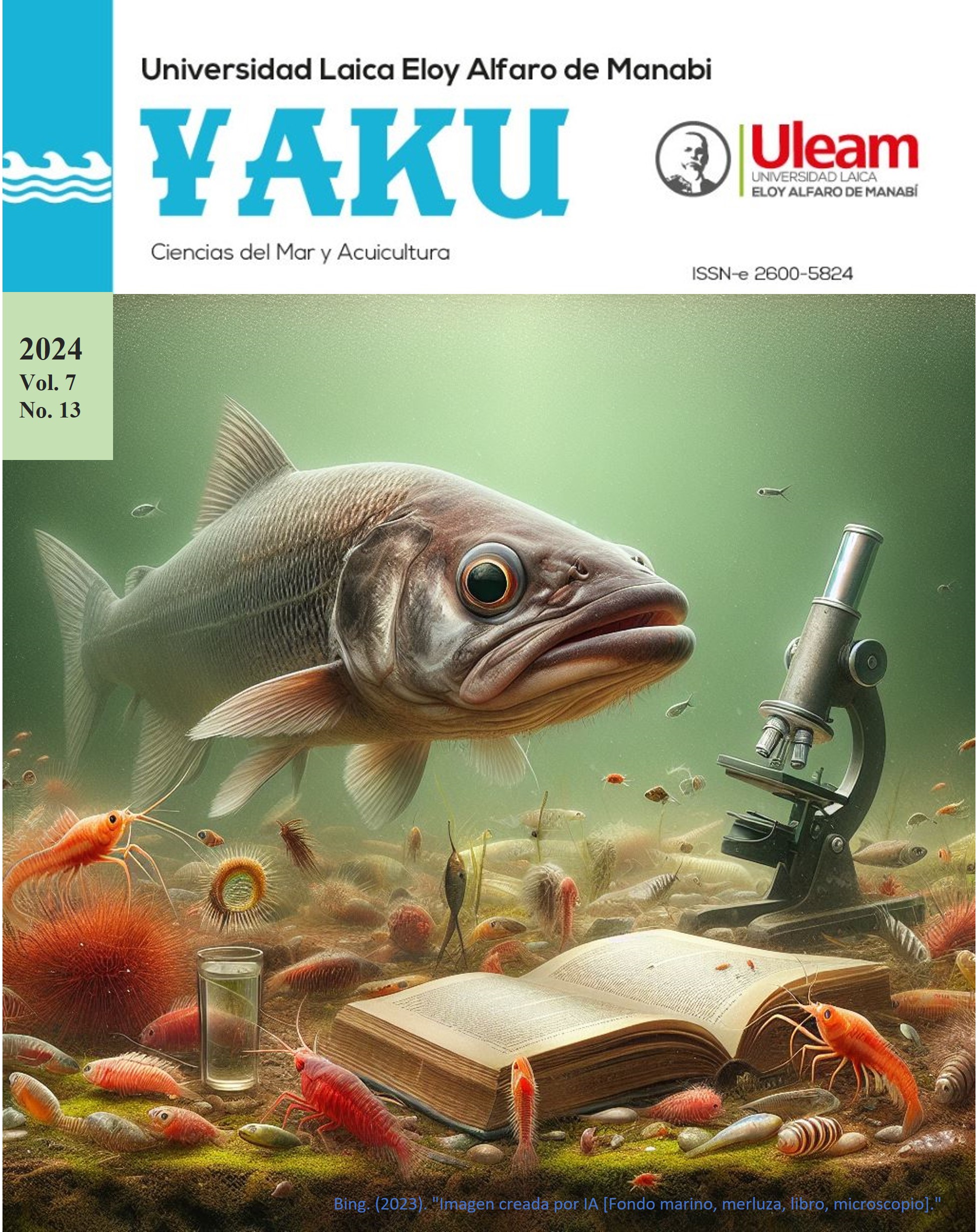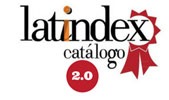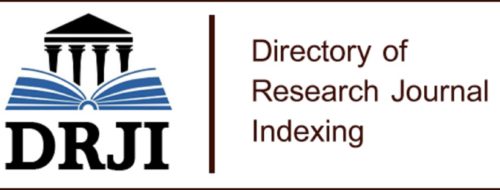Variation of the potential geographic distribution of the invasive Lithobates catesbeianus (Ranidae) in Ecuador in the face of climate change
DOI:
https://doi.org/10.56124/yaku.v7i13.002Keywords:
global warming, Kuenm, invasive alien species, bullfrog, simulation modelAbstract
Ecuador, with its wide range of climates and biodiversity, faces the challenge of the expansion of invasive species such as Lithobates catesbeianus, which may benefit from future climate variations. This study modeled the potential distribution of L. catesbeianus in Ecuador under climate change scenarios using international baseline records and scientific literature. Bioclimatic variables relevant to the species were downloaded and 1581 candidate models were constructed with the KUENM package and Maximum Entropy algorithm in R. The species prevailed mainly in the coastal region, especially in Guayas, Los Ríos, Manabí, Santa Elena and Esmeraldas, and in the eastern part in Napo, Morona Santiago and Zamora Chinchipe, the latter being especially favorable for its habitat. Climate favorability decreased in the Sierra. In the moderate scenario (SSP 2 4.5), tolerable changes are expected in areas where the bullfrog is already present. Ecuador's climatic diversity could even favor its expansion. However, in the extreme scenario (SSP 5 8.5), a considerable loss of areas with favorable climatic conditions is expected, but the species could still maintain populations, especially within protected areas. The range of expansion for the bullfrog's distribution is expected to increase in areas such as the Cayambe Coca Ecological Reserve, Cotacachi Cayapas, Churute Mangroves and Sangay and Llanganates National Parks. This will result in a higher prevalence of the species in the SNAP but will also cause the loss of biodiversity and local fauna.
Downloads
References
Abad, R. C., & Casal, R. F. (2020). Técnicas de Remuestreo. Madrid: https://rubenfcasal. github. io/book_remuestreo
Akmentins, M. S., & Cardozo, D. E. (2010). American bullfrog Lithobates catesbeianus (Shaw, 1802) invasion in Argentina. Biological invasions, 12, 735-737. https://doi.org/10.1007/s10530-009-9515-3
Beaumont, L. J., Gallagher, R. V., Thuiller, W., Downey, P. O., Leishman, M. R., & Hughes, L. (2009). Different climatic envelopes among invasive populations may lead to underestimations of current and future biological invasions. Diversity and Distributions, 15(3), 409-420. https://doi.org/10.1111/j.1472-4642.2008.00547.x
Becerra-López, J. L., Esparza Estrada, C. E., Romero Méndez, U., Sigala Rodríguez, J. J., Mayer Goyenechea, I. G. & Castillo Cerón, J. M. (2017). Evidence of niche shift and invasion potential of Lithobates catesbeianus in the habitat of Mexican endemic frogs. Plos One, 12(9), e0185086. https://doi.org/10.1371/journal.pone.0185086
Beaumont, L. J., Gallagher, R. V., Thuiller, W., Downey, P. O., Leishman, M. R., & Hughes, L. (2009). Different climatic envelopes among invasive populations may lead to underestimations of current and future biological invasions. Diversity and Distributions, 15(3), 409-420. https://doi.org/10.1111/j.1472-4642.2008.00547.x
Bissattini, A. M. & Vignoli, L. (2017). Let’s eat out, there’s crayfish for dinner: American bullfrog niche shifts inside and outside native ranges and the effect of introduced crayfish. Biological Invasions 19(9), 2633–2646. https://doi.org/10.1007/s10530-017-1473-6
Bonilla, J. A. (2019). Distribución potencial de la especie Lithobates catesbeianus en la región continental de Colombia bajo iteraciones de cambio climático. Recuperado de: http://hdl.handle.net/10654/31932.
Booth, T. H. (2022). Checking bioclimatic variables that combine temperature and precipitation data before their use in species distribution models. Austral Ecology 47: 1506-1514. https://doi.org/10.1111/aec.13234
Boria, R. A., Olson, L. E., Goodman S. M. & Anderson, R. (2014). Spatial filtering to reduce sampling bias can improve the performance of ecological niche models. Ecological Modelling 275: 73-77. https://doi.org/10.1016/j.ecolmodel.2013.12.012
Chamberlain, S., Oldoni, D. & Waller, J. (2022). rgbif: Interface to the Global
Biodiversity Information Facility API. https://doi.org/10.5281/zenodo.6023735
Cobos, M. C., Penichet, C. N., & Valarezo-Aguilar, K. (2015). First record of an American Bullfrog (Lithobates catesbeianus) population in Loja, Ecuador. Reptiles & Amphibians, 22(1), 46-48.
Cobos, M. E., Peterson, A. T., Barve, N. & Osorio‐Olvera, L. (2019). kuenm: an R package for detailed development of ecological niche models using Maxent. PeerJ, 7, e6281. https://doi.org/10.7717/peerj.6281
Cruz-Cordovez, C., Herrera, I., Espinoza, F., Rizzo, K., Sarmiento, M-B., Rodas, N., Coello, M-J., Bravo, W. & Lampo, M. (2020). New record of a feral population of Lithobates catesbeianus Shaw, 1802 in a protected area (Santay Island) in the Ecuadorian coast. BioInvasions Records 9(2): 421–433. https://doi.org/10.3391/bir .2020.9.2.28
Daszak, P., Strieby, A., Cunningham, A. A., Longcore, J. E., Brown, C. C., & Porter, D. (2004). Experimental evidence that the bullfrog (Rana catesbeiana) is a potential carrier of chytridiomycosis, an emerging fungal disease of amphibians. Herpetological Journal, 14, 201-208.
Datta, A., Schweiger, O. & Kühn, I. (2020). Origin of climatic data can determine the transferability of species distribution models. NeoBiota 59: 61-76. https://doi.org/10.3897/neobiota.59.36299
De Andrade, A. F. A., Velazco, S. J. E., & De Marco Júnior, P. (2020). ENMTML: An R package for a straightforward construction of complex ecological niche models. Environmental Modelling and Software, 125, 104615. https://doi.org/10.1016/j.envsoft.2019.104615
Dueñas, M-A., Hemming, D., Roberts, A. & Diaz-Soltero, S. (2021). The threat of invasive species to IUCN-listed critically endangered species: a systematic review. Global Ecology and Conservation, 26, e01476. https://doi.org/10.1016/j.gecco.2021.e01476
Dueñas Tituaña, M. R. (2020). Efectos de la variabilidad climática en la distribución espacial de la rana invasora Lithobates catesbeianus (Shaw 1802) (Anura: Ranidae) en el Ecuador continental para evaluar su respuesta frente al cambio climático (Master's thesis, Quito: Universidad Tecnológica Indoamérica).
Ferrer-Sánchez, Y., Jacho-Saa, W. R., Urdánigo Zambrano, J. P., Abasolo-Pacheco, F., Plasencia-Vázquez, A. H., Zambrano-Mero, G. J., ... & Estrella Bravo, G. V. (2021). Invasiones biológicas en agroecosistemas de Ecuador continental: nicho ecológico de especies exóticas y cultivos agrícolas bajo riesgo. Acta Biológica Colombiana, 26(3), 352-364.
Fick, S. E. & Hijmans, R. J. (2017). WorldClim 2: new 1km spatial resolution climate surfaces for global land areas. International Journal of Climatology 37 (12): 4302-4315. https://doi.org/10.1002/joc.5086
Forti, L. R., Becker, C. G., Tacioli, L., Pereira, V. R., Santos, A. C. F., Oliveira, I., ... & Toledo, L. F. (2017). Perspectives on invasive amphibians in Brazil. Plos One, 12(9), e0184703. https://doi.org/10.1371/journal.pone.0184703
Gallagher, R. V., Beaumont, L. J., Hughes, L., & Leishman, M. R. (2010). Evidence for climatic niche and biome shifts between native and novel ranges in plant species introduced to Australia. Journal of Ecology, 98(4), 790-799. https://doi.org/10.1111/j.1365-2745.2010.01677.x
Govindarajulu, P. (2004). Introduced bullfrogs (Rana catesbeiana) in British Columbia: impacts on native Pacific treefrogs (Hyla regilla) and red-legged frogs (Rana aurora). Dissertation. University of Victoria, Victoria, British Columbia, Canada.
Govindarajulu, P., Altwegg, R., & Anholt, B. R. (2005). Matrix model investigation of invasive species control: bullfrogs on Vancouver Island. Ecological Applications, 15(6), 2161-2170. https://doi.org/10.1890/05-0486
Hanselmann, R., Rodrıguez, A., Lampo, M., Fajardo-Ramos, L., Aguirre, A. A., Kilpatrick, A. M., ... & Daszak, P. (2004). Presence of an emerging pathogen of amphibians in introduced bullfrogs Rana catesbeiana in Venezuela. Biological Conservation, 120(1), 115-119. https://doi.org/10.1016/j.biocon.2004.02.013
Haubrock, P. J., Cuthbert, R. N., Hudgins, E. J., Crystal‐Ornelas, R., Kourantidou, M., Moodley, D., Liu, C., Turbelin, A. J., Leroy, B. & Courchamp, F. (2022). Geographic and taxonomic trends of rising biological invasion costs. Science of the Total Environment, 817, 152948. https://doi.org/10.1016/j.scitotenv.2022.152948
Hellmann, J. J., Byers, J. E., Bierwagen, B. G., & Dukes, J. S. (2008). Five potential consequences of climate change for invasive species. Conservation Biology, 22(3), 534-543. https://doi.org/10.1111/j.1523-1739.2008.00951.x
Holt, R. D. (1990). The microevolutionary consequences of climate change. Trends in Ecology & Evolution, 5(9), 311-315. https://doi.org/10.1016/0169-5347(90)90088-U
Iñiguez, C. A., & Morejón, F. J. (2012). Potential distribution of the American bullfrog (Lithobates catesbeianus) in Ecuador. South American Journal of Herpetology, 7(2), 85-90. https://doi.org/10.2994/057.007.0211
Kumschick, S., Measey, G. J., Vimercati, G., De Villiers, F. A., Mokhatla, M. M., Davies, S. J., ... & Kraus, F. (2017). How repeatable is the Environmental Impact Classification of Alien Taxa (EICAT)? Comparing independent global impact assessments of amphibians. Ecology and Evolution, 7(8), 2661-2670. https://doi.org/10.1002/ece3.2877
Laufer, G., Kacevas, N. & Gobel, N. (2021). La rana toro (Lithobates catesbeianus): Estado de invasión, efectos y posibilidades de manejo en Uruguay. En A. Brazeiro, D. Bresciano, E. Brugnoli & M. Iturburu (Eds.), Especies Exóticas Invasoras de Uruguay: Distribución, Impactos Socioambientales y Estrategias de Gestión (1era ed., 175-189). RETEMA-UdelaR, CEEI-Ministerio de Ambiente. https://hdl.handle.net/20.500.12008/31864
Mainka, S. A., & Howard, G. W. (2010). Climate change and invasive species: double jeopardy. Integrative Zoology, 5(2), 102-111. https://doi.org/10.1111/j.1749-4877.2010.00193.x
Moodley, D., Angulo, E., Cuthbert, R. N., Leung, B., Turbelin, A. & Diagne, C. (2022). Surprisingly high economic costs of biological invasions in protected areas. Biological Invasions, 24, 5-6. https://doi.org/10.1007/s10530-022-02732-7
Narváez, A. E., Barreno, M., Cuadrado, S., Vera, K., & Molina-Moreira, N. (2023). Updated distribution of an alien frog species, Lithobates catesbeianus (Shaw, 1802), in Ecuador: new records of Bullfrog in the semideciduous lowland forest of western Ecuador. Check List, 19(4), 533-539. https://doi.org/10.15560/19.4.533
Nori, J., Urbina-Cardona, J. N., Loyola, R. D., Lescano, J. N., & Leynaud, G. C. (2011). Climate change and American bullfrog invasion: what could we expect in South America?. PloS One, 6(10), e25718.
Osorio‐Olvera, L., Lira‐Noriega, A., Soberón, J., Peterson, A. T., Falconi, M., Contreras-Díaz, R. G., Martínez‐Meyer, E., Barve, V. & Barve, N. (2020). ntbox: An r package with graphical user interface for modelling and evaluating multidimensional ecological niches. Methods in Ecology and Evolution, 11(10), 1199-1206. https://doi.org/10.1111/2041-210x.13452
Peterson, A. T., Cobos, M. E., & Jiménez‐García, D. (2018). Major challenges for correlational ecological niche model projections to future climate conditions. Annals of the New York Academy of Sciences, 1429(1), 66-77. https://doi.org/10.1111/nyas.13873
Phillips, S. J., & Dudík, M. (2008). Modeling of species distributions with Maxent: new extensions and a comprehensive evaluation. Ecography, 31(2), 161-175. https://doi.org/10.1111/j.0906-7590.2008.5203.x
Phillips, S. J., Anderson, R. P., & Schapire, R. E. (2006). Maximum entropy modeling of species geographic distributions. Ecological Modelling, 190(3-4), 231-259. https://doi.org/10.1016/j.ecolmodel.2005.03.026
Prass, M., Ramula, S., Jauni, M., Setala, H. & Kotze, J. (2022). The invasive herb Lupinus polyphyllus can reduce plant species richness independently of local invasion age. Biological Invasions, (24), 425–436. https://doi.org/10.1007/s10530-021-02652-y
Pyron, R. A., Burbrink, F. T., & Guiher, T. J. (2008). Claims of potential expansion throughout the US by invasive python species are contradicted by ecological niche models. PLoS One, 3(8), e2931. https://doi.org/10.1371/journal.pone.0002931
Pyšek, P., Hulme, P. E., Simberloff, D., Bacher, S., Blackburn, T. M., Carlton, J. T., ... & Richardson, D. M. (2020). Scientists' warning on invasive alien species. Biological Reviews, 95(6), 1511-1534. https://doi.org/10.1111/brv.12627
Ravi, S., Law, D. J., Caplan, J. S., Barron‐Gafford, G. A., Dontsova, K. M., Espeleta, J. F., ... & Huxman, T. E. (2022). Biological invasions and climate change amplify each other’s effects on dryland degradation. Global Change Biology, 28(1), 285-295. https://doi.org/10.1111/gcb.15919
Rodda, G. H., Jarnevich, C. S., & Reed, R. N. (2011). Challenges in identifying sites climatically matched to the native ranges of animal invaders. PloS One, 6(2), e14670. https://doi.org/10.1371/journal.pone.0014670
Sales, L., Rebouças, R. & Toledo, L. F. (2021). Native range climate is insufficient to predict anuran invasive potential. Biological Invasions 23, 2635–2647. https://doi.org/10.1007/s10530-021-02528-1
Soberón, J., & Peterson, A.T. (2005). Interpretation of models of fundamental ecological niches and species’ distributional areas. Biodiversity Informatics, 2, 1–10. https://doi.org/10.17161/bi.v2i0.4
Urbina, J., Bredeweg, E. M., Garcia, T. S. & Blaustein, A. R. (2018). Host–pathogen dynamics among the invasive American bullfrog (Lithobates catesbeianus) and chytrid fungus (Batrachochytrium dendrobatidis). Hydrobiologia 817(1), 267–277. https://doi.org/10.1007/s10750-018-3614-z
Urbina-Cardona, J. N., Nori, J., & Castro, F. (2011). Áreas vulnerables a la invasión actual y futura de la rana toro (Lithobates catesbeianus: Ranidae) en Colombia: estrategias propuestas para su manejo y control. Biota Colombiana, 12(2).
Valarezo-Aguilar, K., Cisneros-Heredia, D. F., & Ordonez-Gutierrez, O. (2016). A new distribution record for the invasive American Bullfrog, Lithobates catesbeianus (Shaw, 1802)(Anura: Ranidae), from eastern Ecuador. Reptiles & Amphibians, 23(2), 147-149.
Vargas, C., Encarnación-Luévano, A., Ortega-Andrade, H.M., Prieto-Torres, D.A., Peña-Peniche, A., Rojas-Soto, O.R. (2020). Una breve introducción a los modelos de nicho ecológico. En: Moreno, C.E. (Ed.) La biodiversidad en un mundo cambiante: Fundamentos teóricos y metodológicos para su estudio (39-63). Universidad Autónoma del Estado de Hidalgo/Libermex.
Yang, X., Zhou, B., Xu, Y. & Han, Z. (2021). CMIP6 Evaluation and Projection of Temperature and Precipitation over China. Advances in Atmospheric Sciences, 38(5), 817-830. https://doi.org/10.1007/s00376-021-0351-4
Yuan, L., Li, J. M., Yu, F. H., Oduor, A. M., & van Kleunen, M. (2021). Allelopathic and competitive interactions between native and alien plants. Biological Invasions, 23(10), 3077-3090. https://doi.org/10.1007/s10530-021-02565-w
Published
How to Cite
Issue
Section
License
Copyright (c) 2024 Revista de Ciencias del Mar y Acuicultura YAKU. ISSN: 2600-5824.

This work is licensed under a Creative Commons Attribution-NonCommercial-ShareAlike 4.0 International License.


1.jpg)













